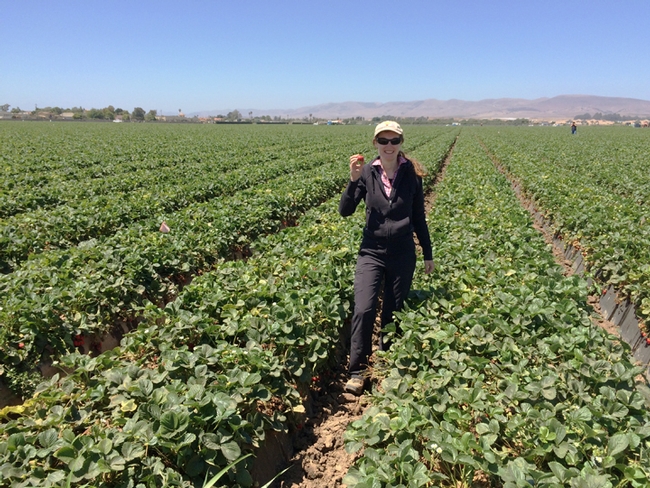- Author: Kathy Keatley Garvey
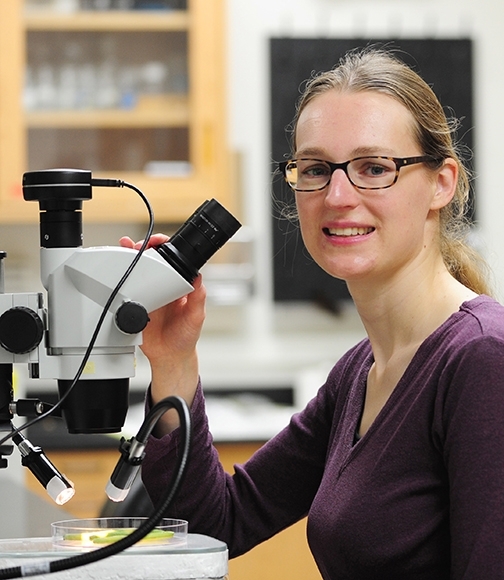
The authors and their paper, “Drones: Innovative Technology for Use in Precision Pest Management,” will be recognized at the Entomological Society of America (ESA) meeting, set Oct. 31-Nov. 3 in Denver.
"On behalf of our team, first author Fernando lost Filho, a doctoral student in entomology at the University of São Paulo, Brazil, and a former UC Davis exchange student, will deliver the presentation at the ESA meeting," said de Lange, a former postdoctoral fellow in the Christian Nansen laboratory at the UC Davis Department of Entomology and Nematology and now of The Netherlands.
Other co-authors are remote sensing expert Wieke Heldens of the German Aerospace Center, Wessling, Germany; and engineer and drone communication expert Zhaodan Kong, associate professor, UC Davis Department of Mechanical and Aerospace Engineering.
“Drones can be equipped with a range of attachments, such as sensors, pesticide sprayers, and natural enemy releasers, and can therefore contribute to more sustainable agriculture in various ways,” said de Lange, who assembled the team and serves as the corresponding author.
“They are highly versatile," she said, "and have great commercial potential.”
Their paper, one of the first-of-its-kind to summarize scientific literature on the use of agricultural drones for pest management, covers the use of drones with remote sensing equipment to detect pest problems from the air. It calls for the increased use of actuation drones, to provide solutions such as spraying pesticides and releasing biocontrol organisms.
JEE Award. Every year the editors-in-chief and editorial boards of the Journal of Economic Entomology (JEE) and Environment Entomology along with ESA and Oxford University Press, select outstanding research publications for special recognition. The categories include Editors' Choice, Readers' Choice and Reviewers' Choice.
For the JEE Editors' Choice award, the editors-in-chief nominate papers based on citation, readership and Altmetric scores. The winners are determined by a vote of the JEE subject editors. JEE co-editors-in-chief are Frank Zalom, UC Davis distinguished professor of entomology; Mike Brewer, entomology professor, Texas A&M University; and Nan-Yao Su, distinguished professor of entomology at the University of Florida. JEE is ESA's largest journal by publishing volume and the most-cited journal in entomology. (See ESA website.)
ESA announced the awards online. All of the winning papers are currently online.
Improving Crop Monitoring Procedures. “Early outbreak detection and treatment application are inherent to effective pest management, allowing management decisions to be implemented before pests are well-established and crop losses accrue,” the authors wrote in their abstract. “Pest monitoring is time-consuming and may be hampered by lack of reliable or cost-effective sampling techniques. Thus, we argue that an important research challenge associated with enhanced sustainability of pest management in modern agriculture is developing and promoting improved crop monitoring procedures.”
Drones can target pest outbreaks or hot spots in field crops and orchards, such as Colorado potato beetle in potato fields or sugarcane aphid in sorghum, the scientists pointed out. “Pests are unpredictable and not uniformly distributed. Precision agricultural technologies, like the use of drones, can offer important opportunities for integrated pest management (IPM).”
De Lange, who holds a doctorate in chemical ecology from the University of Neuchâtel, Switzerland, joined the Nansen lab in 2016. Her research interests include plant-insect interactions, integrated pest management, chemical ecology and precision agriculture. She focused much of her research on California strawberries.
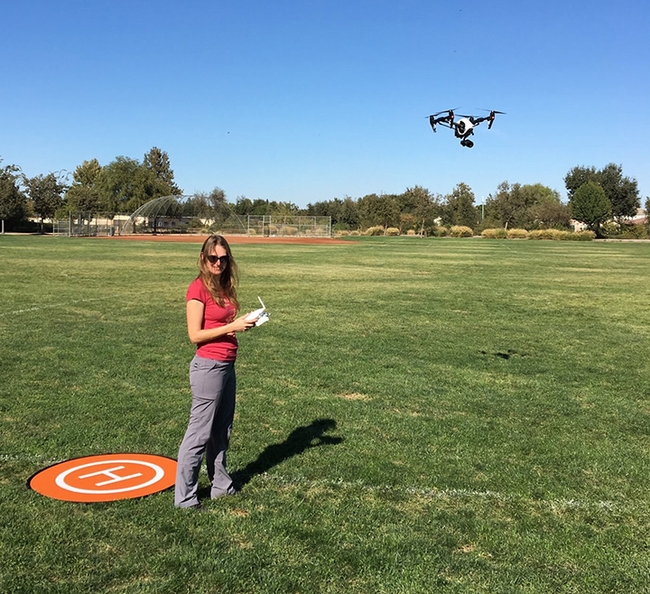


- Author: Kathy Keatley Garvey
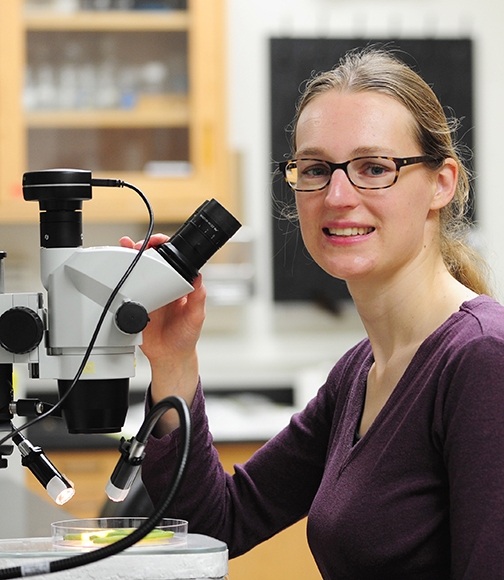
The review paper, “Drones: Innovative Technology for Use in Precision Pest Management,” is one of the first of its kind to summarize scientific literature on the use of agricultural drones for pest management.
In advocating the need for more research, the authors said that drones are becoming an important part of precision pest management, from detecting pests to controlling them.
“We propose extensive communication and collaboration between scientists from various disciplines, extension agents, industry professionals, and commercial growers to reach drones' optimal potential to help with pest management and control,” said De Lange, the corresponding author and a postdoctoral fellow in the Christian Nansen lab, UC Davis Department of Entomology and Nematology who assembled the team of authors.
The paper covers the use of drones with remote sensing equipment, to detect pest problems from the air. It calls for the increased use of actuation drones, to provide solutions such as spraying pesticides and releasing biocontrol organisms.
“Most literature concerns remote sensing,” said de Lange.
"Drones became indispensable for IPM programs in Brazil, specially for Biological Control," said lead author and entomologist Fernando Iost Filho of the Department of Entomology and Acarology, University of Sao Paulo, Brazil. "They are currently being used for releasing parasitoids in thousands of acres of field crops, such as sugarcane and soybean,
said Filho, a former exchange student at UC Davis. "Their use for monitoring crop health is also expected to increase in the Brazilian fields in the next few years."
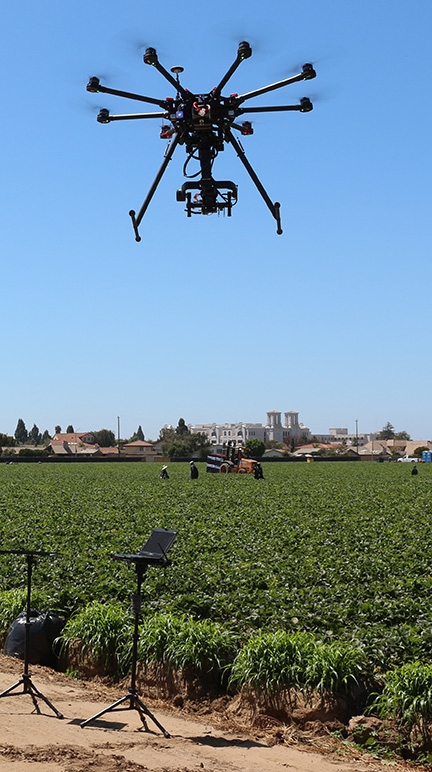
“Early outbreak detection and treatment application are inherent to effective pest management, allowing management decisions to be implemented before pests are well-established and crop losses accrue,” the authors wrote in their abstract. “Pest monitoring is time-consuming and may be hampered by lack of reliable or cost-effective sampling techniques. Thus, we argue that an important research challenge associated with enhanced sustainability of pest management in modern agriculture is developing and promoting improved crop monitoring procedures.”
Drones can target pest outbreaks or hot spots in field crops and orchards, such as Colorado potato beetle in potato fields or sugarcane aphid in sorghum, the scientists pointed out. “Pests are unpredictable and not uniformly distributed. Precision agricultural technologies, like the use of drones, can offer important opportunities for integrated pest management (IPM).”
De Lange, noting that drones are increasingly used in agriculture for various purposes, commented: “They are often equipped with remote sensing technology, for yield predictions, evaluation of crop phenology, or characterization of soil properties.”
“There are myriad possibilities for use of drones in pest management,” she said. “Sensing drones, equipped with remote sensing technology, could help detect pest hotspots. Pests are often small and hard to find, so indirect detection, through changes in how plants reflect light, has the potential to find the pest earlier, treat earlier, and keep damage in check.”
“Furthermore, actuation drones, equipped with precision spray rigs or dispensers of biocontrol organisms, could apply localized solutions. Pesticide sprays exactly where needed would reduce the needs to spray an entire field. More efficient distribution of biocontrol organisms would make them a more competitive alternative to pesticides.”
“Remote sensing equipment,” she added, “can also be placed on manned aircraft and satellites. However, drones fly lower, increasing images' spatial resolution, and making clouds less of an issue. They are generally cheaper and can be flown more frequently. Compared to ground-based devices, drones can cover much more ground in a shorter period of time.”
The authors said that drones could also be used to distribute sterile insects and mating disruption, and contribute to pest outbreak prevention, rather than provide only solutions to existing problems.
De Lange, who holds a doctorate in chemical ecology from the University of Neuchâtel, Switzerland, joined the Nansen lab in 2016. Her research interests include plant-insect interactions, integrated pest management, chemical ecology and precision agriculture. She does much of her research on California strawberries.
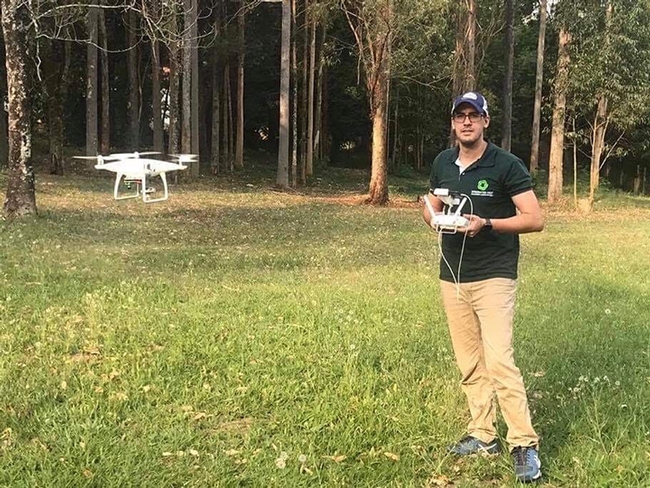
- Author: Kathy Keatley Garvey
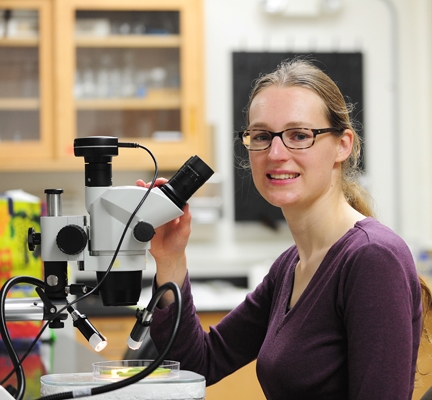
Chemical ecologist Elvira Simone de Lange, a postdoctoral researcher in the Christian Nansen lab, UC Davis Department of Entomology and Nematology, has received a three-year $249,878 federal grant that involves using drones to detect the early infestation of spider mites, and then targeting the pests with biocontrol agents.
The grant is from the U.S. Department of Agriculture's Western Sustainable Agriculture Research and Education (SARE) Program.
Her research project, "Unmanned Aerial System (UAS)-Guided Releases of Predatory Mites for Management of Spider Mites in Strawberry," aims to identify “very subtle differences in reflectance of the strawberry canopy, indicating spider mite-induced stress,” she said. “Releasing predatory mites in these spider mite hotspots will increase their efficacy as biocontrol agents, enhancing sustainability of spider mite management practices in strawberry.”
In her successfully funded proposal, she noted that “Farmers are requesting in-depth testing of how UAS can be integrated successfully into strawberry production to improve management practices.” UAS, or drones, can monitor large areas in a short period of time. California produces 88 percent of the nation's strawberries, with an annual value of approximately $2.6 billion.
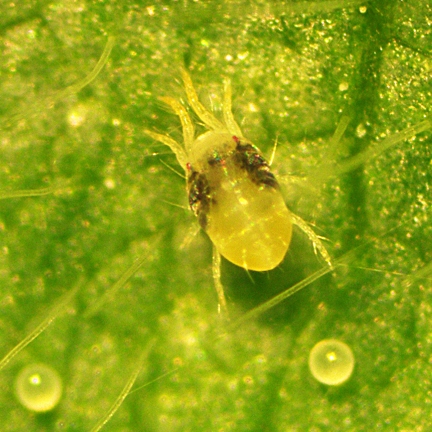
The three-year project, now underway through March 2020, also explores the use of drones as a novel, effective way of distributing the predatory mites.
The grant also calls for educational outreach programs, with hands-on workshops and lectures on spider mite sampling at grower and agriculture professional meetings throughout the California strawberry growing region. Growers outside this area will be reached through publications in trade journals and other grower media.
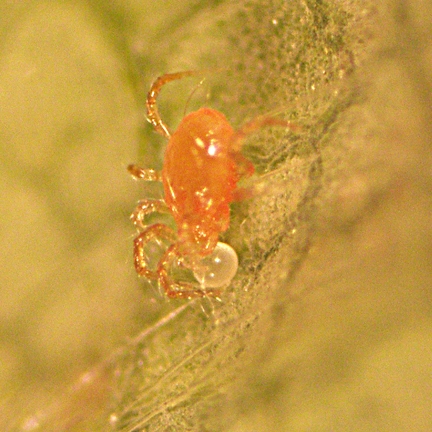
Multiple species of spider mites infest the state's strawberry fields. The twospotted spider mite, Tetranychus urticae, an annual pest of strawberries in all growing regions, is the predominant species in strawberries grown on the Central Coast, according to the UC Statewide Integrated Pest Management Program's Pest Management Guidelines (PMG), written by lead author and IPM specialist Frank Zalom, distinguished professor of entomology, UC Davis Department of Entomology and Nematology.
The mites suck plant juices. The damage can result in decreased fruit size and yield. Mite-feeding symptoms include dense webbing, and dry, brittle and discolored leaves.
“Twospotted spider mite feeding is particularly damaging during the first two to five months following transplanting in late summer or fall,” according to the PMG.
A native of The Netherlands, de Lange joined the Nansen lab in March 2016. She received her bachelor's degree in biology, and her master's degree in plant biology from Utrecht University, The Netherlands. She earned her doctorate in chemical ecology from the University of Neuchâtel, Switzerland. Her first postdoctoral position was at Rutgers University, New Jersey, where she worked on insect resistance in cranberries.
Overall, she hopes her research meshing chemical ecology, entomology, plant-arthropod interactions and biological control in the fields of integrated pest management and precision agriculture solutions, will “lead to the development of novel, sustainable pest management practices.”
